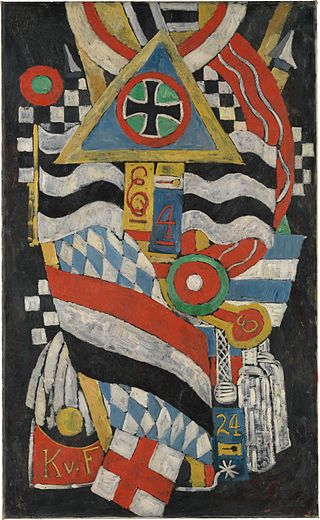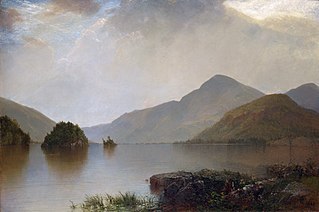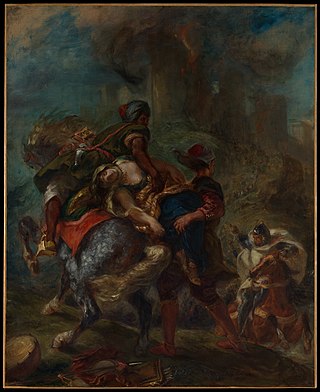
The Metropolitan Museum of Art in New York City, colloquially "the Met", is the largest art museum in the Americas. In 2022 it welcomed 3,208,832 visitors, ranking it eighth in the list of most-visited art museums in the world, and the second-most visited art museum in the United States. Its permanent collection contains over two million works, divided among 17 curatorial departments. The main building at 1000 Fifth Avenue, along the Museum Mile on the eastern edge of Central Park on Manhattan's Upper East Side, is by area one of the world's largest art museums. The first portion of the approximately 2-million-square-foot (190,000 m2) building was built in 1880. A much smaller second location, The Cloisters at Fort Tryon Park in Upper Manhattan, contains an extensive collection of art, architecture, and artifacts from medieval Europe.

François Boucher was a French painter, draughtsman and etcher, who worked in the Rococo style. Boucher is known for his idyllic and voluptuous paintings on classical themes, decorative allegories, and pastoral scenes. He was perhaps the most celebrated painter and decorative artist of the 18th century.

Charles Henry Buckius Demuth was an American painter who specialized in watercolors and turned to oils late in his career, developing a style of painting known as Precisionism.

Marsden Hartley was an American Modernist painter, poet, and essayist. Hartley developed his painting abilities by observing Cubist artists in Paris and Berlin.

JohannesLingelbach (1622–1674) was a Dutch Golden Age painter, associated with the second generation of Bambocciate, a group of genre painters working in Rome from 1625–1700.

The Ogunquit Museum of American Art is a small art museum located on the coast in Ogunquit, Maine. The museum houses over 3,000 pieces in its permanent collection.

Neuberger Museum of Art is located in Purchase, New York, United States. It is affiliated with Purchase College, part of the State University of New York system. It is the nation's tenth-largest university museum. The museum is one of 14 sites on the African American Heritage Trail of Westchester County.
Gertrude Tiemer Wille was an American painter, photographer, and poet. Tiemer achieved her greatest notoriety for inter-dimensional, multi-exposure photography. Her paintings of landscapes, still lifes, portraits, and other pieces adopted both the realist and abstract styles of art. Tiemer exhibited her work at galleries in Maine, New York City, and other venues throughout the U.S. and internationally.

The Fog Warning is one of several paintings on marine subjects by the late-19th-century American painter Winslow Homer (1836–1910). Together with The Herring Net and Breezing Up, painted the same year and also depicting the hard lives of fishermen in Maine, it is considered among his best works on such topics.

Portrait of a German Officer is an early 20th century portrait by American modernist painter Marsden Hartley. Done in oil on canvas, the portrait depicts the abstract figure of an Imperial German officer as being composed entirely of military decorations and badges of rank. The painting is currently on display at the Metropolitan Museum of Art.

Sergeant of the Colonial Regiment is an early 20th century painting by French artist Albert Marquet. It is in the collection of the Metropolitan Museum of Art in New York city.

Moonlight, Wood Island Light is a late 19th-century oil painting by American artist Winslow Homer. The painting is currently in the collection of the Metropolitan Museum of Art in New York.

Lake George is a mid 19th century painting by American artist John Frederick Kensett. Done in oil on canvas, the painting depicts Lake George in upstate New York. The painting is in the collection of the Metropolitan Museum of Art.

Lady at the Tea Table is a late 19th-century painting by American artist Mary Cassatt. The work, done in oil on canvas, is in the collection of the Metropolitan Museum of Art.

Ferry near Gorinchem is a mid 17th century painting by Dutch artist Salomon van Ruysdael. Done in oil on canvas, the work depicts a riverside embankment near Gorinchem in the Netherlands; in addition, the painting also depicts the prominent St Jan's Tower of the Grote Kerk, the town's church. Ruysdael's rendering of the land near Gorinchem was possibly impacted due to the artist's owning of a mill on the river. The work is in the collection of the Metropolitan Museum of Art.
Lawrence Arthur Jones (1910-1996) was a twentieth century African-American artist and printmaker. Born in Lynchburg, Virginia, Jones spent most of his career as an art teacher in Louisiana, Georgia, and Mississippi. He was a contemporary of the prominent black artists Charles White and Eldzier Cortor. Jones's most notable accomplishment is his establishment of a fine arts program at Jackson State University in Mississippi.

The Abduction of Rebecca is a mid-19th century painting by French artist Eugène Delacroix. Done in oil on canvas, the work depicts the a scene from Sir Walter Scott's novel Ivanhoe in which the heroine Rebecca is abducted. Delacroix produced the painting during the height of the French Romanticist Movement, and presented the work at the Paris Salon of 1846. The 1846 version of Abduction is currently in the collection of the Metropolitan Museum of Art, which describes the work as "one of Delacroix’s greatest paintings". In 1858 Delacroix created an almost identical work for the Paris Salon of 1859; the second version of Abduction is in the collection of the Louvre.

Bermuda No. 2, The Schooner is an early 20th century drawing by American artist Charles Demuth. Done in watercolor and graphite on paper, the work depicts the ship Danish ship Elsa. The drawing is in the collection of the Metropolitan Museum of Art.

Cemetery, New Mexico is an early 20th century painting by American artist Marsden Hartley. Done in oil on canvas, the painting depicts a cemetery in Taos Pueblo, New Mexico. The work is in the collection of the Metropolitan Museum of Art.

Christ Presented to the People is a mid 16th century painting by Giovanni Antonio Bazzi, an Italian artist commonly known as Il Sodoma. Done in oil on canvas, the work depicts the biblical scene in which Jesus Christ is presented to the people by Pontius Pilate with the phrase "Ecce homo". The painting is in the collection of the Metropolitan Museum of Art.



















